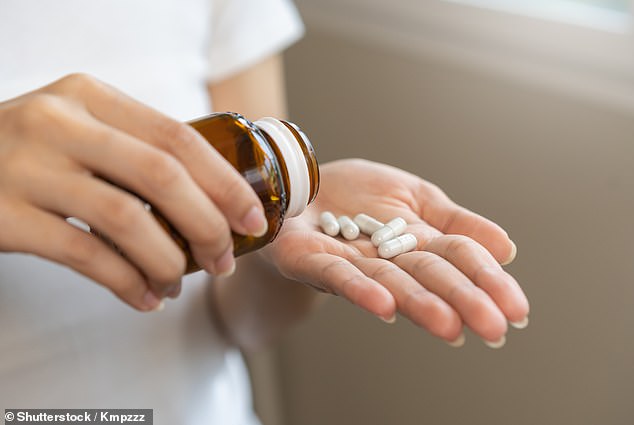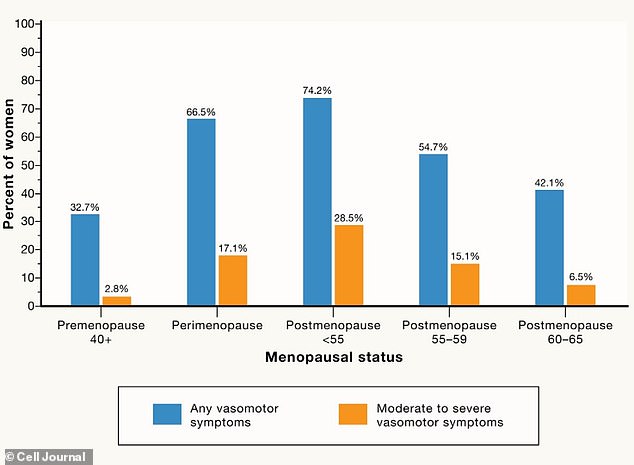Not getting enough SUN may raise risk of early menopause and more severe symptoms, study suggests
Vitamin D could prevent early menopause and its most serious symptoms, another study suggests.
Results from a study of data from 6,000 American women indicated that women who don’t get enough of the sunshine vitamin are one-third more likely to make “the change” before age 45.
One theory is that vitamin D slows down the aging of the ovaries. It is also thought to help with symptoms such as hot flashes because vitamin D protects against falling serotonin levels, which helps regulate body temperature.
Early menopause robs women of the chance to have children naturally and can mean symptoms are more severe. It can also increase the risk of weak bones and heart disease.
Black women and ethnicities with darker skin are most at risk because they need more sunlight to get vitamin D.
Menopause symptoms include hot flashes, night sweats, mood swings, sleep disturbances and cognitive problems, which can have a significant impact on women’s lives

Vitamin D can prevent early menopause and its most serious symptoms

This graph from the study in Cell shows the number of menopausal women in each age group experiencing vasomotor symptoms, commonly known as hot flashes or night sweats.
The CDC recommends that between five and 10 mcg per day is sufficient for most people.
You can buy supplements from 20 cents per pill.
The CDC recommends that older adults, people with dark skin, and people who are not exposed to enough sunlight should consume extra vitamin D.
There are other ways to get enough vitamin D, including dietary supplements and vitamin D-fortified foods. The majority of people can get their vitamin D through these channels.
Researchers from Isfahan University of Medical Sciences in Iran reviewed data from 6,326 American women who had gone through menopause.
The data dates from 2001-2018 and comes from the National Health and Nutrition Examination Survey (NHANES) database.
The study used self-reported data from a questionnaire to assess participants’ age at menopause and reproductive longevity – the time between a woman’s first and last menstrual period.
Women were divided into three categories (early menopause, normal menopause and late menopause) based on their age at menopause.
Early menopause was defined as before the age of 45 years, normal menopause was defined as menopause between the ages of 45 and 55 years, and late menopause was defined as menopause after the age of 55 years.
Reproductive lifespan was categorized as less than 33 years, between 34-38 and more than 38 years.
As part of the study, women also had their vitamin D levels measured via a blood test.
The research shows that women with a vitamin D deficiency have up to a 34% greater chance of early menopause.
Lower vitamin D levels were also associated with a higher risk of shorter reproductive lifespan.
However, when the results were adjusted for age, race, education level and wealth, no link was found between vitamin D levels and early menopause.
When the results were adjusted for age, smoking, alcohol consumption, pregnancy, chronic comorbidities and BMI, the association was statistically significant.
Menopause is a normal part of aging and occurs when the ovaries stop producing eggs. As a result, the levels of the hormones that the ovaries produce fall.
A characteristic sign of menopause is that affected women stop menstruating.
Nearly nine in ten women experience menopausal symptoms, including hot flashes, night sweats, mood swings, sleep disturbances, and cognitive problems, such as anxiety and low self-esteem, as well as memory or concentration problems.
Other symptoms include sexual problems, bladder problems, and a dry vagina.
Symptoms usually develop before menopause officially begins, during a period called perimenopause. During this time, women’s periods become irregular, hot flashes begin, and fertility declines.
For some, this only takes a few months, but it can take as long as four to eight years.
The average age of onset of menopause in the US is 51 years old. Those who undergo these between the ages of 40 and 45 have what doctors call “early menopause.”
After menopause, women enter postmenopause. This is when a woman has not had a period for more than a year and symptoms such as hot flashes, vaginal dryness, and changes in sex drive persist.
This lasts for the rest of a woman’s life.
